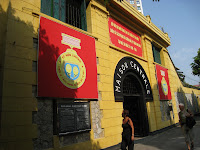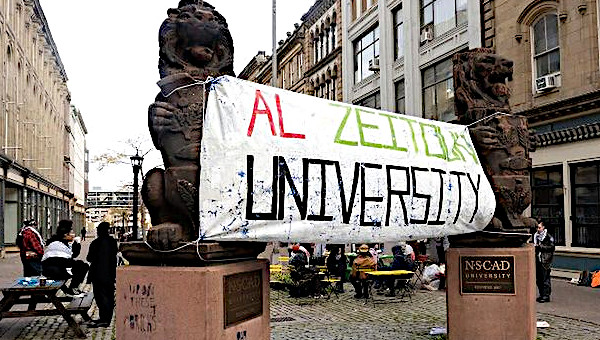
This morning, the televisions at the international hostel I am staying at here in Hanoi, were showing the last presidential debate between Obama and McCain. As I watched on and off, along with a crowd of other foreigners staying here, it struck me that since I am in Hanoi maybe I should visit the prison where McCain was kept, after being shot down on one of his missions carpet-bombing innocent civilians of Hanoi.
Better known to the Westerners as Hanoi Hilton, this prison "was built after the decision [by the French colonialists] to form the Union of Indochina [on] October 17, 1887," according to the booklet you can purchase at the prison-cum-museum. The construction of the prison started in 1896, in the area that was formerly a village, named Phu Khanh Village. According to the booklet, "The Phu Khanh village used to be a handicraft professional village specializing in producing ceramic house ware. The ... villagers fired their pottery kilns all day and night, hence the village had another name of Hoa Lo (fired pottery kilns)."
In order to build the prison, the French administrators confiscated about 1.3 square km of land, driving out some 48 households, and called the prison Maison Centrale (Cetnral Prison), but it became known as the Hoa Lo Prison.
The location of the prison is what is now called the Old Quarter in Hanoi, which happens to be the backpackers' area as well these days. The streets in this section of the city vary from narrow to very narrow to just walkable, and they are arranged in all kinds of directions (an anti-grid, if you like). Thousands of small shops line the streets, and streets are crowded with cars, thousands of motorbikes, bicycles, panhandlers and people, and the sidewalks used as parking space for the motorbikes, or sidewalk tiny restaurants with plastic tiny stools and plastic low tables. These don't look very appetizing to a Westerner, but the food is usually healthy, delicious and very cheap.
According to the museum guidebook, "The prison's capacity in its initial design was 500 prisoners, but it had to be continuously adjusted and restructured to minimize the area of the stores and the healthcare center and maximize the jail area ... In the years 1950-1953, Hoa Lo Prison held up to 2000 prisoners. Some detention rooms were so crowded that the prisoners had to request to take the weaker ones out so that they were not suffocated."
Of course, from the very start of its operations, the French faced constant resistance inside the prison, most notably hunger strikes. The prisoners were naturally highly politicized and they took their imprisonment as just another phase of their struggle against the colonialists. Communist party cells were formed there and political education was constant.
A very interesting invention comes to attention when reading the little guidebook on the prison. It says that the Vietnamese prisoners, all revolutionaries and resistant fighters against the French, invented a special kind of ink to write their secret documents. "The ink was two types of medicine, namely mercurochrome which has red color, and methylene blue: both were taken from the healthcare center. The diluted mercurochrome used as ink made the writing invisible. To read it, the prisoners would soak it in the liquid of cooked rice." (Take notes, those of you planning to resist seriously!).
Among the artifacts on display were tools of torture and execution. There was a sample small electrical generator, which together with electrical wiring would be used on men and women alike (seems like things have not changed much from Hoa Lo to Abu Ghuraib). Another object, used specifically on women, was simply a bottle. Readers can imagine what kind of torture could have been practiced on women political prisoners using that.
There is a guillotine on display at the museum, used by the French for executing the political prisoners held there. Prisoners who were condemned to death had their legs in fixed (to the concrete) iron fetters (whose locks were outside the cells), all day and all night, and had to do everything while shackled down. At the museum, gruesome pictures and artifacts remind the visitors of the kind of 'civilization' the French were attempting to tempt the Vietnamese with. There is a picture of three severed heads in baskets, and the note said that the French used to display the severed heads so as to terrorize the rest into submission.
In a sharp contrast, the museum had pictures of the American pilots who had been shot down, while running carpet-bombing missions over Hanoi, and kept as prisoners in Hoa Lo Prison. There are pictures of the American pilots receiving medical care, receiving mail and pictures from family and friends, and even pictures of the American pilots decorating a large Christmas tree, cooking their Christmas meals, playing basketball and volleyball. There were pictures showing that upon being released, the American pilots were receiving souvenirs even; I wonder if McCain kept his.
I took some photos at the museum (which was allowed). One was of John McCain receiving medical care; he doesn't look too happy, his right arm in bandages. Another picture shows him (I think it's him, anyway) at the front of a group of prisoners walking in formation, as they are being released. And there was also his pilot's suit and parachute on display. There was also a picture of him in April 2000, when he visited the Hoa Lo Prison Museum.
As I was walking around the museum, and looking at all the photos of the American pilots doing not too bad, compared to those perishing in Abu Ghuraib and Guantanamo prisons, and also compared to how the French colonialists treated the Vietnamese resistance fighters, all I could think was: Would any of the Abu Ghuraib prisoners be allowed to observe their festivities? Or, receive letters and pictures from family and friends? Or play basketball and volleyball?





No comments:
Post a Comment